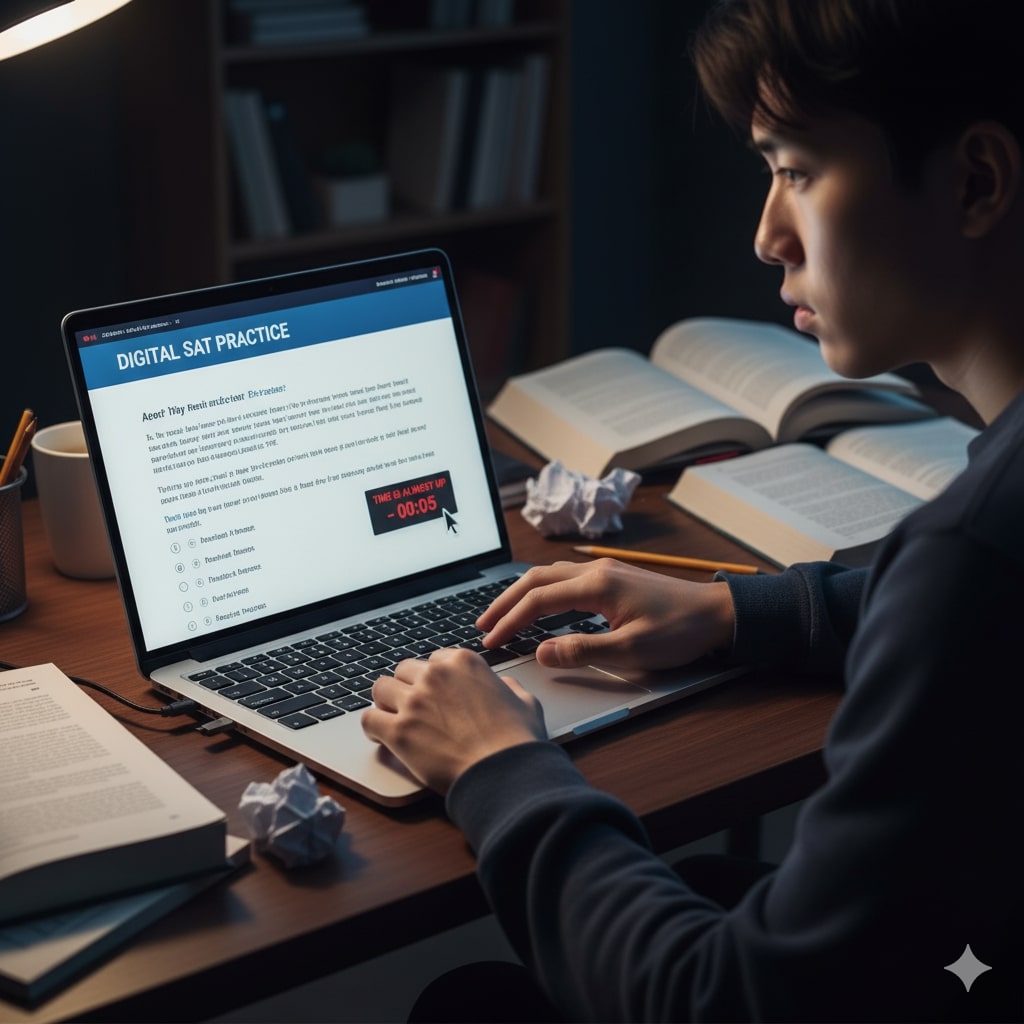Why Guessing Strategy Matters in Digital SAT Practice
Let’s be real: test day is a mix of nerves, focus, and the occasional question that makes you pause. On the Digital SAT, every second and every answer can shift your final score. That’s why guessing—when done thoughtfully—isn’t a last resort. It’s a strategy. This blog walks you through exactly why guessing matters, the logic behind smart guesses, time-saving habits, and simple drills you can practice so that when you sit down for the test, you’re not crossing your fingers—you’re executing.
The new digital playground — what changed and what stayed the same
The Digital SAT looks and feels different from the paper test, but the essential goal is unchanged: demonstrate what you know. One important technical shift is how the digital scoring model factors in the difficulty and characteristics of the items you answer. That means two students who get the same number of questions right can still receive different scaled scores depending on which specific questions they got right. In short: precision matters.
Because the digital test uses algorithms that consider question difficulty and response patterns, leaving questions blank is generally less advantageous than making an educated guess—especially when you can eliminate one or more incorrect options. A blank answer tells the scoring model nothing; a reasoned guess can still provide evidence of skill, or at least preserve opportunity.
The mechanics: Why a well-placed guess often beats leaving it empty
Imagine a multiple-choice question you don’t know outright. You have a few choices: panic and leave it, pick randomly, or use strategies to increase the odds. Here’s why smart guessing pays off:
- Statistical advantage: If you can eliminate one or two options, your chance of selecting the correct answer rises substantially. That converts a 1-in-4 shot into a 1-in-3 or even 1-in-2.
- Algorithmic nuance: The digital scoring model considers the difficulty of the questions you answered correctly. Getting a harder question right can raise your scaled score more than an easier question. A thoughtful guess on a question where you eliminate choices might net you that high-value correct answer.
- Opportunity cost: Leaving a question blank wastes a chance to score. With limited time, you’ll want to maximize every moment by using elimination skills and moving on confidently when guessing.
A short example to anchor this
Suppose you face a four-choice reading question and you can confidently rule out two answers because they distort the passage’s tone. Random guessing gives you a 25% shot; eliminating two options bumps your odds to 50%. That’s real improvement. Over a section of 44 questions, applying elimination even a few times can translate into several additional correct answers and, because of how the digital scoring considers question difficulty, a measurable bump in scaled score.
Three smart guessing techniques you can practice
Not all guesses are equal. Here are three practical, repeatable tactics that turn guesswork into strategy.
1) Eliminate first, guess later
Before you commit to an answer, quickly cross off what’s impossible. Look for absolute words, contradictions with the passage or the question stem, and choices that only partially answer the prompt. When you narrow the field, you’re increasing expected value of that guess.
- Tip: In the Bluebook environment you can highlight or mark choices to visually keep track of eliminated options.
- Practice drill: On practice sets, force yourself to write down eliminated answers for 10–15 questions per section. The extra second you spend training this habit will feel much faster on test day.
2) Use the process of substitution for math problems
For algebra or word problems, plug in easy numbers or use back-substitution from the answer choices. If you can’t immediately solve the equation, test answer choices quickly to eliminate impossibilities. Often one substitution disqualifies two or three choices at once.
- Tip: Become familiar with the embedded Desmos calculator in the digital test. Practicing substitution with that tool during your prep saves time later.
- Practice drill: Time yourself doing substitution: 60 seconds per question to force economy and to identify which question types this works best for.
3) Make a best-answer heuristic for reading and writing
When two choices look plausible in a reading question, prefer answers that are explicit in the passage and avoid those that overreach. In writing questions, prefer concise, direct constructions unless the question asks for style or nuance. Formulate the “best answer” rule (not just the “not-worst” answer) and use it consistently.
- Tip: Train yourself to find the line in the passage that most directly supports an answer. If a choice requires inference beyond what’s supported, cross it out.
- Practice drill: Do a batch of 20 reading questions where you underline the supporting sentence before choosing an answer.
Time management: When to guess and when to linger
Time pressure is the biggest enemy of clear thinking on test day. A disciplined timing plan reduces the need for panic guessing and gives you room to use elimination effectively.
A simple time-allocation framework
Use a timing template during practice so it becomes second nature. Here’s an adaptable guideline:
| Section | Questions | Suggested pace per question | When to move on |
|---|---|---|---|
| Reading | 44 (modules vary) | ~70–90 seconds | If you’ve spent 2x the average and made no progress, mark & guess |
| Writing & Language | 44 (modules vary) | ~60–75 seconds | If sentence logic or grammar rules aren’t clicking, eliminate and guess |
| Math — No Calculator/Calculator | 30–40 per module | ~90–120 seconds | Try substitution or back-solve; if both stall, mark & guess |
This is a flexible template—modify it based on your natural speed. The key habit is to avoid letting a single question consume more than double your target time. If you linger, you risk losing multiple questions’ worth of time.
Two-pass strategy
Try a two-pass approach during practice: first pass answer the straightforward questions; second pass return to the tougher ones with more time and focus. On the second pass you’ll be making more educated guesses because you’ve warmed up and have a better sense of how the passage or problem aligns with the choices.
Psychology of guessing: staying calm and confident
Guessing well isn’t just mechanical—it’s mental. Test anxiety shrinks working memory and can make elimination feel impossible. Here are practical mental habits to keep your head clear.
- Simplify the tradeoff: Every unanswered question is opportunity lost. Reframe guessing as tactical, not desperate.
- Anchor with breathing: A 10-second breathing reset will clear a fogged mind and often reveal an elimination you missed.
- Trust your instincts (informed ones): If you consistently find that your first reasonable choice is right more often during practice, learn to trust that heuristic instead of overthinking.
Practice drills that build reliable guessing instincts
Practice is where guessing becomes a skill, not a gamble. Here are drills to add to your study plan.
Elimination-only drill
Use a set of 30 multiple-choice questions. For each, spend no more than 30 seconds listing eliminated answers before making a choice. Track how often you guess correctly when you eliminated at least one option. Over time you’ll see the statistical benefit solidify.
Timed back-substitution sweep
For math sections, practice a 15-minute block where you intentionally skip problems you can’t start in under a minute and use back-substitution on the rest. Count corrects and note which types of problems responded well to substitution.
Passage-support drill
On reading passages, underline the best supporting sentence before looking at answer choices. If your chosen answer isn’t directly supported, you’ll know to eliminate it. Track accuracy to build confidence that passage anchoring works.
How scoring interacts with guessing: practical implications
Because the digital scoring model looks at the difficulty and pattern of your answers, strategic guessing can have layered effects. Correct answers to more challenging items improve scaled scores more than easy items. That means there’s upside to carefully guessing on questions that seem difficult—especially if you can eliminate distractors. Conversely, random guessing across many items might produce less reward and more noise in the scoring model, so targeted guessing (where you’ve eliminated options) is superior.
Tools in the Digital SAT (and how to use them when guessing)
The digital test provides tools—highlighter, notes, a calculator, and mark-for-review—that change the guessing calculus. Use them smartly:
- Highlights & notes: Mark specific lines in a passage that support or contradict choices so you don’t waste time re-reading.
- Option eliminator: If available, use an eliminator tool to cross out wrong answers visually to keep track when you revisit the question.
- Calculator: For math guessing, use quick calculations to disqualify choices with arithmetic contradictions.

Common guessing mistakes to avoid
- Randomly selecting the same letter: There’s no proven advantage to letter patterns. Focus on elimination instead of patterns.
- Over-guessing too early: Don’t guess immediately on a question where you could eliminate choices with one more read-through.
- Ignoring tools: Failing to use the testing tools (highlight, notes, calculator) wastes opportunities to turn a guess into an educated choice.
How tutoring can refine your guessing strategy—why personalization matters
Guessing is not one-size-fits-all. Your tendencies—whether you are cautious, impulsive, fast, or methodical—shape the best guessing approach for you. That’s where personalized tutoring shines. A tutor can analyze your practice test patterns, identify where you’re losing time, and tailor drills that improve elimination skills or back-substitution speed. For many students, a targeted plan that includes timed practice, error analysis, and simulating test conditions accelerates improvement in a way solo practice rarely does.
For example, a student who consistently misses inference questions in reading could practice passage-anchoring drills and learn to eliminate answers that overreach. Another student might need targeted algebra substitution work to boost success on math guesses. Sparkl’s personalized tutoring can provide one-on-one guidance, tailored study plans, expert tutors, and AI-driven insights to help build these exact habits—making your guessing smarter, not luckier.
Sample scoring scenarios: illustrating the effect of better guessing
Below is a simplified example showing how different strategies play out in a single section of 44 questions.
| Strategy | Correct | Blank | Estimated scaled impact |
|---|---|---|---|
| Conservative (no guessing) | 28 | 16 | Base score: solid but leaves points on table |
| Random guessing on blanks | 30 (estimated) | 14 | Minimal gain, inconsistent with difficulty weighting |
| Educated guessing (eliminate 1–2 choices) | 33 (estimated) | 11 | Improved scaled score due to more corrects and possible harder-item hits |
Note: This table is illustrative. Scaled score shifts depend on many factors, including question difficulty and the pattern of answers across sections. The key idea stands: educated guessing tends to outperform leaving questions blank or random guessing.
Putting it all together: a week-by-week guessing practice plan
If you have six weeks until your test, here’s a focused plan to build strong guessing skills that fit into a broader study schedule.
- Week 1: Baseline practice test. Note how many blanks vs. guesses you made and your accuracy on guessed questions.
- Week 2: Elimination drills—30 minutes daily. Track improvements in elimination success rate.
- Week 3: Time management work—two-pass strategy practice and pacing templates.
- Week 4: Math substitution/back-substitution drills and calculator practice in the Bluebook format.
- Week 5: Simulated full-length digital tests under timed conditions; practice marking and returning to questions efficiently.
- Week 6: Final refinement—focus on weak spots identified in full-lengths; practice calm, quick resets for test day.
Throughout this plan, review your mistakes not to punish yourself but to detect patterns: Which question types are you guessing on most? Are you losing time on passage setup or computation? That analysis is the value-multiplier for everything you practice next.
Final thoughts: transform guessing from gamble to strategy
Good guessing on the Digital SAT is deliberate, practiced, and strategic. It’s not about blind luck; it’s about applying a handful of reliable techniques: eliminate first, use substitution smartly, anchor your reading answers in the passage, and manage your time with a disciplined template. The scoring model rewards accurate demonstration of skill—and an educated guess is a way to preserve and sometimes even improve that demonstration when you don’t know an answer outright.
If you want the fastest path from good intentions to dependable guessing skills, consider combining disciplined self-practice with personalized tutoring that addresses your unique patterns. Programs like Sparkl’s personalized tutoring offer one-on-one guidance, tailored study plans, expert tutors, and AI-driven insights that can help you refine guessing into a high-ROI part of your testing toolkit. With intentional practice and the right support, guessing becomes not something to fear, but a tool you wield with confidence.
One last tip for test day
When you finish a section, take one deep breath before you click to the next. That small pause helps reset your focus and primes you to use educated guessing effectively when the next tricky question arrives. You’ve trained, you’ve drilled, and you know the methods—now it’s about executing them calmly, one deliberate choice at a time.
Ready to practice smarter?
Start with a timed diagnostic, add short daily elimination drills, and review every mistake like a scientist. Over weeks, educated guessing will stop feeling like luck and start feeling like another predictable advantage in your test-taking toolkit. You’ve got this.


















No Comments
Leave a comment Cancel